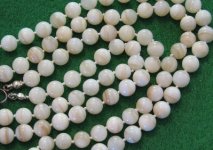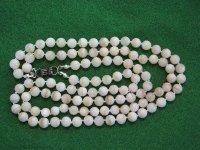B
boo
Guest
I was wondering if I could get some opinions on a necklace I bought a while back. The person selling it (who I consider reasonably trustworthy) said that it was sold at the closing of a particular well known jewelry store, and described as being "mother of pearl beads cut from the shell of the oyster that produces our Akoya pearls". They are more dull than I would expect of true mother of pearl (although there are some spots that do glow), and they are cream colored with brown striations. They actually kind of remind me of a picture of pearl nuclei that I saw here some time ago, and Jeremy's video made me think of that again. Any thoughts?
(I did restring it, but have kept the original (tarnished) clasp.)
(I did restring it, but have kept the original (tarnished) clasp.)


